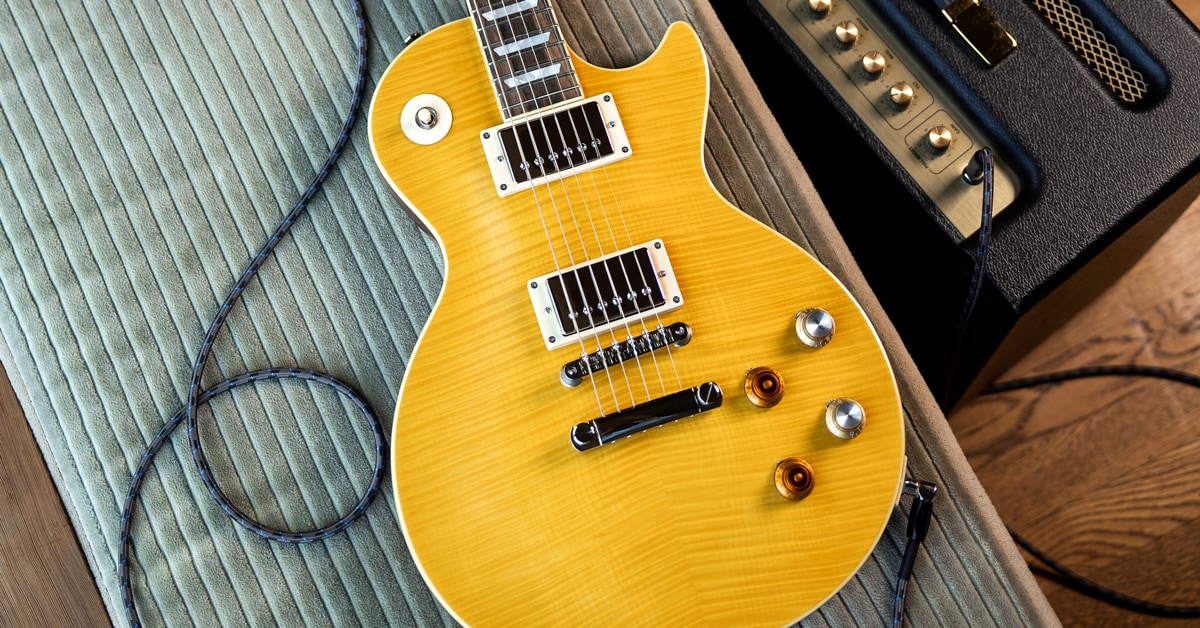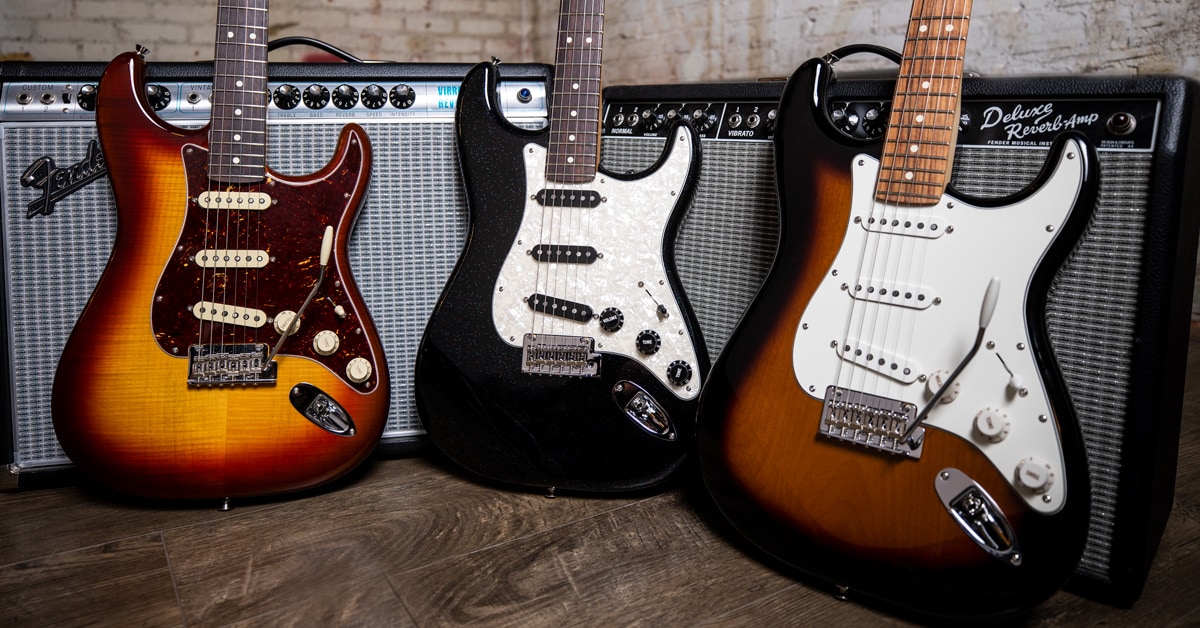Break out the cake, because the Fender Stratocaster is having a big birthday. Fender, and the world, are celebrating the 70th Anniversary of one of the most iconic and influential electric guitars ever built.
While many other electric guitars have come and gone over those seven decades, the Strat, like its older sibling, the Leo Fender-designed Fender Telecaster, is still visibly the same Stratocaster guitar that debuted in 1954, despite some minor cosmetic changes and some fairly profound internal changes over the years.
In this article, we're going to look at what it is about this particular design that has kept it (and variations on its design) in the fore as one of the most popular and versatile electric guitars in the world.
If you're interested in picking up a new Strat and looking for some suggestion and model-specific information, be sure to check out How to Buy The Best Stratocaster.
Table of Contents
What Makes a Stratocaster So Great?
The History of the Fender Stratocaster
Who Designed the Stratocaster?
Stratocaster Design Team
The Early Years of the Fender Stratocaster
What Does "Pre-CBS" Mean?
Changes to the Stratocaster in the CBS Era
The Beginning of the Superstrat
The Stratocaster in the '80s and Beyond
The Stratocaster After CBS
The Fender Custom Shop
Evolution of the Stratocaster
How the Neck Changed
How the Fingerboard Changed
How the Fingerboard Radius Changed
How the Frets Changed
How the Truss Rod Design Changed
How Body Wood and Contouring Changed
The Top 10 Strat Players By Decade
Stratocaster Pioneers of the 1950s
Top Stratocaster Players of the 1960s
Stunning Strat Players of the '70s
Great Strat Players of the 1980s and '90s
Contemporary Strat Artists
The Fender Stratocaster at 70
What Makes a Stratocaster So Great?
When the Strat debuted in the late spring of 1954, it was like nothing any guitar player had seen before. Here's why...
- The Body. While there had been previous double-cutaway solidbody electric guitars—most notably one made by Paul Bigsby for Ernest Tubb guitarist Billy Byrd in 1949—the Stratocaster borrowed the elongated upper-bout cutaway from Fender's revolutionary 1951 Precision Bass design. This not only created a better balanced, less neck-heavy instrument, but, combined with the new body contours, made the guitar look more streamlined and futuristic. It also made the instrument more comfortable to play. But what attracted players more than the looks was the way the darn thing sounded.
- The Pickups. Leo Fender was, first and foremost, an electronics guy, and pickup design was always one of his first points of attack on a new instrument design. In those early, pre-rock ’n’ roll days, Fender believed that clean and clear—with enough high-frequency content to cut through—and superb string-to-string articulation, was what players would best respond to in the sound of a pickup.
- The Sound. Listening to what may be the first recorded track using a Strat, Texas blues artist Pee Wee Crayton's 1954 recording of "The Telephone is Ringing," it's obvious the guitar rings out in a way far different from previous electric guitar recordings, with a bell-like, spanky tone.
- Fender Synchronized Tremolo Bridge. Adding to the Strat's instantly recognizable tone was the unique one-piece "Synchronized Tremolo" bridge—although it’s actually a vibrato, as has been pointed out incalculable times on the Internet. By creating a steel block as a solid anchor for the strings and reducing their length—compared to competing vibrato systems—as well as keeping the strings from having to move over the bridge saddle, Fender's soon-to-be-patented design improved tuning stability and increased inherent sustain. This increase in tuning stability was enhanced by the straight string pull of the six-on-a-side setup of the tuners. The bridge, with its knife-edge pivoting action and ability to "float," was capable of far more extreme action than existing vibratos and was used by players like Bill Carson to mimic steel guitar effects.
- Customization. The Stratocaster—like all of Leo Fender’s guitars and basses—is a modular design, which makes it a superlative guitar platform for customization, modification and even adaptation to a player’s exacting preferences. Leo Fender’s engineering genius—perhaps influenced somewhat by thrill-seeking former GIs whose hot rod mods were driving the burgeoning California car culture—was devising an instrument where necks, electronics and other parts could be swapped out on a whim to create something different. In this case, a hot-rodded Stratocaster that screamed individuality.
You’ll find this legacy of customization in the differences large and small appearing on the current, off-the-shelf Fender Stratocaster models covered in this guide—from varied neck shapes to different pickups and more. But Leo also made it possible for everyday players to have an idea and amend their Stratocasters accordingly, whether it’s a total DIY project or something modded for you by a reputable guitar shop. For exceptionally discerning types, the “build your dream” mantra of the Fender Custom Shop offers a chance for you to design a Stratocaster that is yours and yours alone. Hyper-technical shredders and iconoclasts can mutate the Strat concept even further by seeking out Superstrat models by Charvel, EVH and Jackson.
The History of the Fender Stratocaster
Let’s pause here for a minute to discuss what was also happening in the guitar community as the Stratocaster advanced towards its birth. The Gibson Les Paul had debuted in 1952 as a gold-colored (“goldtop”) set-neck model with two P-90 pickups and a trapeze bridge.
Gretsch released the semi-hollow Duo Jet in 1953—the company was obviously watching the success of Gibson’s goldtop—and the guitar was famously used by George Harrison on the Beatles first album, as well as during the band’s Hamburg, Germany club days. Supro/Valco and a few other solidbody electrics were also on the scene before the Strat debuted in 1954.
Now, back to the Stratocaster…
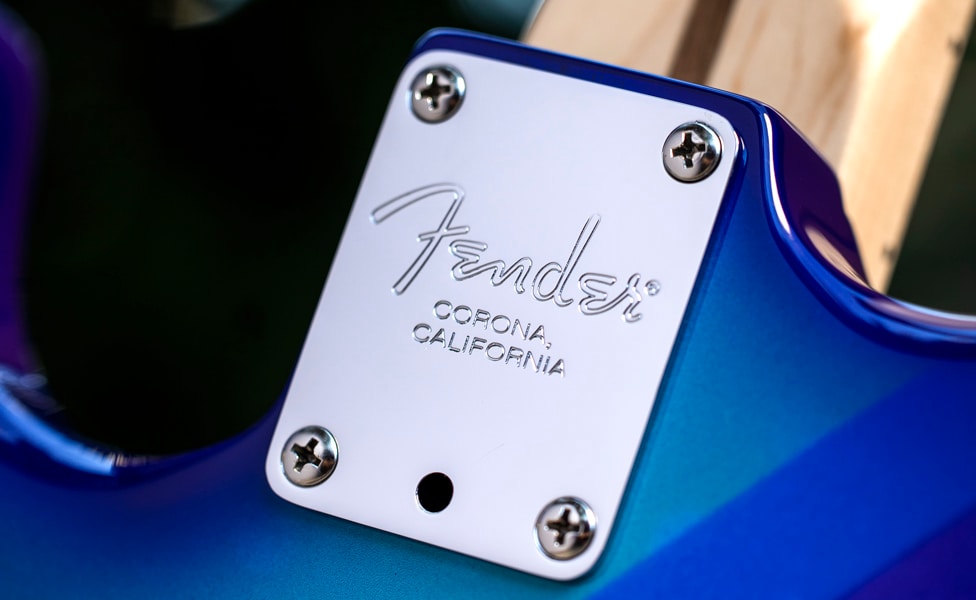
A detailed history of the development of the Fender Stratocaster is destined to be more than a little fuzzy. Many of the people involved weren't interviewed about it until years later. In some cases, it appears modesty (or immodesty) and the simple blurring of memory which comes with time, have led to more than a few variations on what actually happened.
In the end, everybody is the hero of their own story, so we're just trying to assemble the best timeline we can to show how this iconic instrument came to be and how it evolved over the decades.
Who Designed the Stratocaster?
Prior to the 1954 debut of the Stratocaster, the Telecaster (originally known as the Broadcaster, then the Nocaster and finally the Telecaster), was released in 1951. The Telecaster became the blueprint for all mass-produced solidbody electric guitars to come, as we outlined in our Guide to the Fender Telecaster.
Simple and utilitarian, the Tele was the pickup truck of electric guitars—whatever musical job you needed to get done, it would do. But on the aesthetic front, it was very much function trumping form.
Fender's head salesperson, Don Randall, knew this from customer feedback, especially from local guitarist Bill Carson, who had been an early and enthusiastic Tele adopter. Carson consistently provided input on what he thought might make the guitar better.
According to Leo Fender, work on the Stratocaster began in 1951, as the Telecaster and the new Precision Bass began to gather steam. This is where the timeline, as well as who contributed what ideas to the design of the guitar, starts to get blurry. In fact, others involved in Stratocaster development put the date in 1952 or even early 1953.
Where the original Broad/No/Telecaster design had been pretty much the work of Leo Fender—with some assistance from George Fullerton—the Stratocaster seems as if it was much more a team effort. Although, as everyone admits, the final calls on everything were up to the company founder.
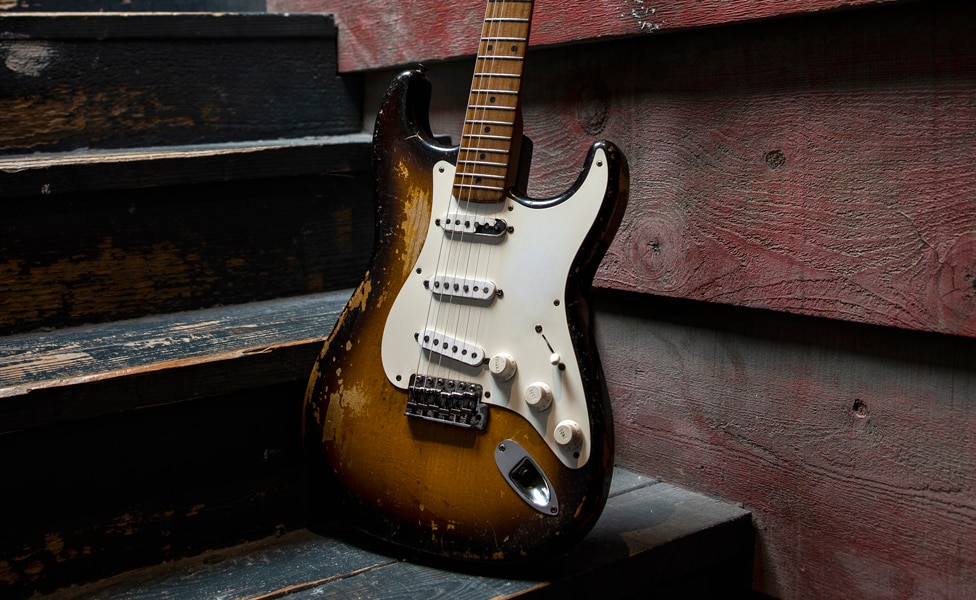
So, who was involved?
The following list encompasses the main group who contributed to the design of the Fender Strat. Certainly, all had important input into the final instrument. Although, as Fender received feedback from many players and their dealers, there are probably others who have never received credit. We apologize for any inadvertent oversights.
For an even deeper dive into the early years of the Strat, check out our article on the evolution of the strat from 1954–1965.
Stratocaster Design Team
- Leo Fender: Legendary founder of the company.
- George Fullerton: Former aerospace machinist and radio repai technician who was hired by Fender in 1948.
- Don Randall: Head of the Fender sales organization.
- Freddie Tavares: Electronics engineer, designer and guitarist.
- Bill Carson: Southern California country guitarists who had been an early Telecaster player.
- Rex Galleon: Another local guitarist who served as a "beta tester" for some of Fender's early guitar concepts.
The Early Years of the Fender Stratocaster
Bill Carson had been gigging regularly with the Eddy Kirk country band, as well as doing session work in and around the Los Angeles area. Both he and Rex Galleon had independently come to the Fender factory (where players were always welcome) to complain about comfort issues with the square-ish edges of the Tele digging into their ribs and right forearms—especially when played seated during long recording sessions.
- Body Contours. Early experiments with contouring the body—none of which, unfortunately, are known to survive—were reportedly done with a Telecaster-style body. But the change in body weight made the guitar too neck heavy. Taking a cue from the 1951 Precision Bass body style, the upper bout was extended to move the strap button, and hence the balance point, further toward the neck.
In early 1953, Leo Fender went to see Freddie Tavares, who had been introduced to Fender by famed steel player Noel Boggs. Tavares offered friendly critiques of some of Fender's own amp designs, and, after examining a couple of the amps Tavares had built for himself, Fender offered him a job on the spot.
One of Tavares first jobs at the Fullerton factory was being asked by Leo to sketch out a new guitar—which had no name yet and was simply known as "the Bill Carson guitar." Of Tavares' numerous contributions to the Strat design, one was to extend the lower cutaway—further improving the balance and better matching the look of the extended upper cutaway. This swooping look is also a big part of what gives the Stratocaster an impact that is still contemporary seven decades later.
As a side note, Tavares was a very active Los Angeles studio steel guitar player, and it's a pretty sure thing anybody reading this has heard him play. The steel guitar glissando at the beginning of the Looney Tunes theme? That's Tavares.
- Intonation. In addition, Galleon and Carson both had issues with the intonation compromises involved in the Telecaster bridge saddles, where each barrel had to serve a pair of strings. Galleon had gone so far as to customize his Telecaster by sawing the barrels in half and tapping new threads, so he could have independent adjustment. These issues were echoed to Leo Fender by Don Randall, who was very active in talking with dealers and players across the country. The solution would be the individual bent-steel saddles, marked "Pat. Pend." that shipped on the final guitar.
- Jackplate. Fullerton was the one who came up with the teardrop-shaped jackplate mounted on the front of the guitar. This solved several practical problems, such as the potential for damage to the instrument if a player inadvertently stepped on their cable, ripping the end out of the guitar. It also simplified the production process, as it meant all the routing for pickups and controls could be done from the top of the guitar.
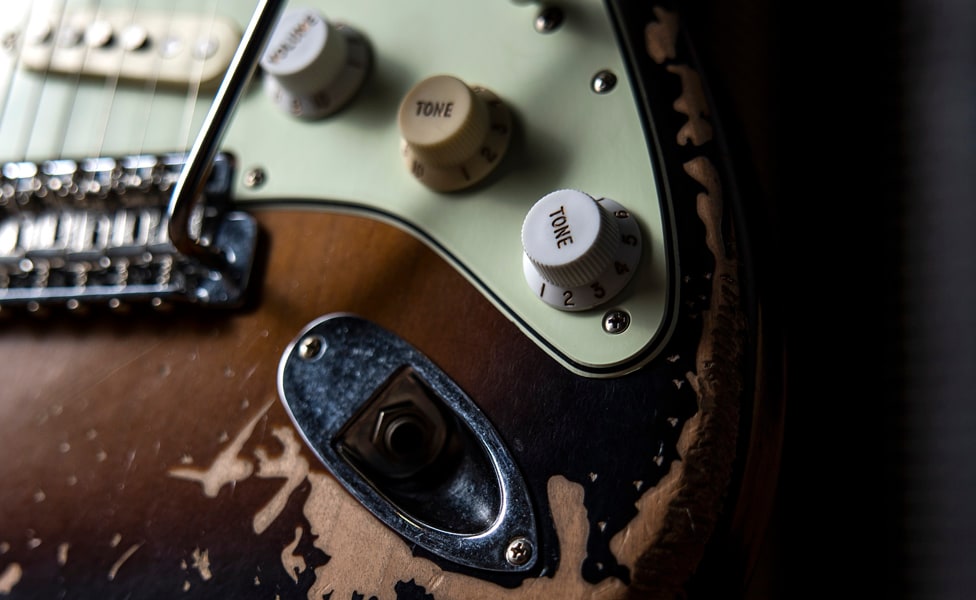
- Pickups. The pickups—as was almost always the case with Fender guitars at the time—were one of Leo Fender's projects. There are varying recollections of why it was decided to have three pickups. Both Randall and Tavares are on record as having said it was an "if two are good, three will be better" situation. Others have said using the existing stock of three-way switches that had been purchased for the Telecaster suggested adding a middle pickup for three distinctive sounds, rather than one sound that was a combination of the neck and bridge pickups.
We may never know which of those it was, but Fender knew he wanted the clarity and articulation of the steel guitars he loved—a sound that had made many country and western swing players fall in love with the Telecaster. Tavares said the pickup development was very much trial and error, experimenting with different wire gauges and magnets to find the combination Fender would approve. Fender may not have been a musician himself, but he was a serious music lover and an astute listener.
Another change to the pickups from the Telecaster design was staggered-height pole pieces. Staggering the pole pieces was not a new idea, as there were already pickups with adjustable pole pieces that could change the string-to-string balance of the instrument. The Fender pickups, though, used individual magnets as pole pieces, rather than a large, permanent magnet at the base of the pickup with steel screws as the pole pieces. The individual magnets improved articulation, but the balance could be a bit off with all the pole pieces at the same height. It was the same thing with the Telecaster pickups.
This lack of balance had come up in Randall and Fender's conversations with dealers and the players who would drop by the factory. With the heavy string gauges at the time, the common complaint was an overly loud B string.
So, another part of the pickup development was experimenting with staggering them to find the right balance. Finally, as with the Telecaster before it, the bridge pickup would be installed at a slant to keep a proper balance between the clear, bright treble that was desired while retaining a solid response from the lower strings—which lost punch the closer the pickup was to the bridge.
An opposite application of the standard Strat bridge-pickup position was famously adopted by Jimi Hendrix. As Hendrix was a lefty, he would buy a right-handed Stratocaster and simply flip it over, which reversed the slant of the bridge pickup. The tonal implications—which may have been subtle, but still an element of the “Hendrix” sound—was that the treble strings were now further from the bridge, producing sweeter, less-bright highs. The bass strings received a bit more articulation and bite by being closer to the bridge.
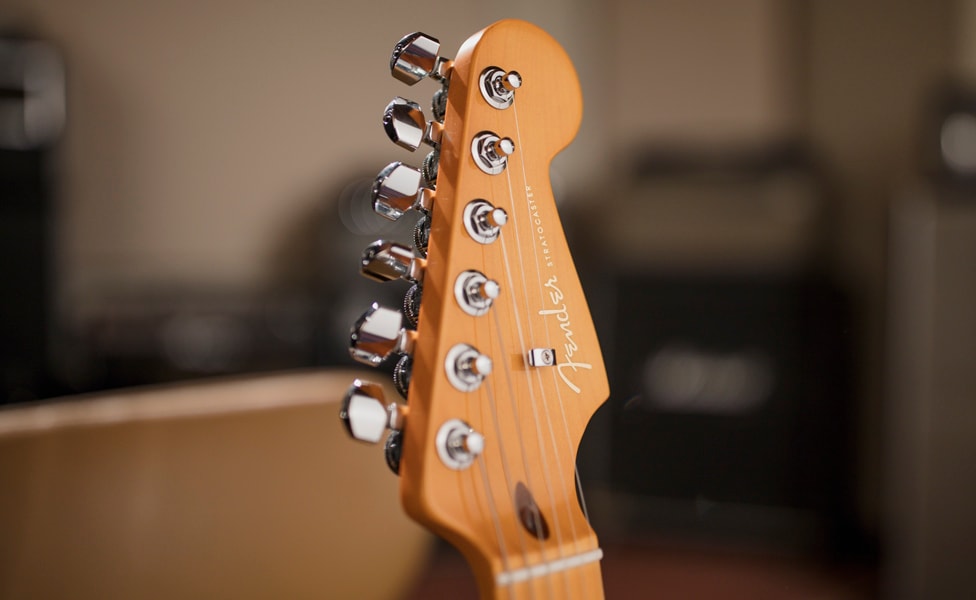
- Headstock. The final step was the name and the headstock. We can rack both of those up in Randall's column, though Tavares did the actual headstock design.
An opposite application of the standard Strat bridge-pickup position was famously adopted by Jimi Hendrix. As Hendrix was a lefty, he would buy a right-handed Stratocaster and simply flip it over, which reversed the slant of the bridge pickup. The tonal implications—which may have been subtle, but still an element of the “Hendrix” sound—was that the treble strings were now further from the bridge, producing sweeter, less-bright highs. The bass strings received a bit more articulation and bite by being closer to the bridge.
- Colors. In 1954, the Stratocaster’s stock finish was two-tone sunburst over an ash body. Although, there are some examples of custom paint jobs at this time, such as a gold finish for Texas Playboys guitarist Eldon Shamblin, and solid red for Bill Carson and Pee Wee Crayton.
However, the color palette soon expanded.
Fullerton is credited with coming up with Fender’s first official color around 1957—Fiesta Red. In 1959, British pop superstar Cliff Richard gifted his guitarist Hank Marvin with a Fiesta Red Stratocaster with gold hardware. That guitar is known as England’s very first Stratocaster, and its appearance helped Marvin, already a guitar hero, become a guitar celebrity with his own hitmaking group, the Shadows (which also did service as Richard’s backing band).
Fender published a color chart for the first time in 1960, embracing the California car craze with automotive-inspired hues such as Olympic White (Cadillac), Blue Ice Metallic (Ford, Mercury), Shoreline Gold (Pontiac), Foam Green (Buick) and Burgundy Mist Metallic (Oldsmobile). Adopting automobile paint was beneficial for Fender, as the guitarmaker had many colors to choose from, the paint was conducive to industrial use, it was easy to apply and it dried fast, and it was readily available.
By autumn of 1953, the Stratocaster design was complete, save for one thing.
- Vibrato Bridge. The most revolutionary aspect of the new guitar was the all-in-one bridge/vibrato unit. The development and refinement of this critical piece of hardware would delay the release of the Stratocaster by six months or so, from late 1953 to almost the middle of 1954.
Fender's initial design for a tremolo was closer to the vibrato which would debut with the Jazzmaster in 1958, with a roller bridge, a separate tailpiece and a fair amount of string length between the bridge and the tailpiece. But when Randall picked up one of the first-run guitars with this vibrato design, it sounded, well, just wrong. There was no sustain and poor tuning stability.
Because the original inspiration had been to create a competitive vibrato to the one Paul Bigsby had created that would be more stable and less complex in construction, Randall took it to Fender and said, "We can't sell these guitars like this."
It was back to the drawing board.
Tavares noted in a later interview about working with Fender that what made him great were not sudden "Eureka!" moments, but his tenacity at finding a solution to a problem and his willingness to throw out ideas that weren't working. The touch that solved this problem was the addition of the cold-rolled-steel block under the bridge, originally referred to as the "inertia block."
The block added mass while firmly anchoring the strings—both of which increased sustain. The fact the strings no longer moved over the bridge with this arrangement greatly helped tuning stability. That the saddles were individually adjustable for both intonation and height was an industry first, helping make the Stratocaster far more adjustable and customizable than any previous electric guitar.
- Release to Retailers.. In May 1954, the first Stratocaster guitars shipped out to dealers—though Forrest White, whom Fender had brought on as factory manager—would say the first real production run of 100 guitars wouldn't happen until October of that year.
At $249.99 ($219.99 for a hardtail version), it was a relatively premium guitar at the time. Don't get too jealous of the pricing, though. Adjusted for inflation, that's approximately $2,800 in 2023 money.
What Does "Pre-CBS" Mean?
During its first decade, there was a stream of small changes to the Stratocaster, such as gradual changes to the neck profile, changes in pickguard material and the like. But larger changes (in some cases, literally) were in the offing when Fender was sold to the Columbia Broadcasting System (CBS) in 1965.
Due to a combination of a cash crunch, as the popularity of the company's products had expanded beyond the factory's capacity, and Leo Fender suffering some persistent health issues, he and Randall started looking for a buyer early in 1964. At this time, Fender was still the sole owner of Fender Musical Instruments, and Randall was a co-owner of the separate Fender Sales company.
It was Randall who, through investment company Merrill Lynch, connected with CBS, which was looking to expand their business beyond broadcasting and record labels. Negotiations continued throughout the year, and on January 5, 1965, the company officially changed hands. Fender and Randall were both brought onboard with five-year consulting contracts.
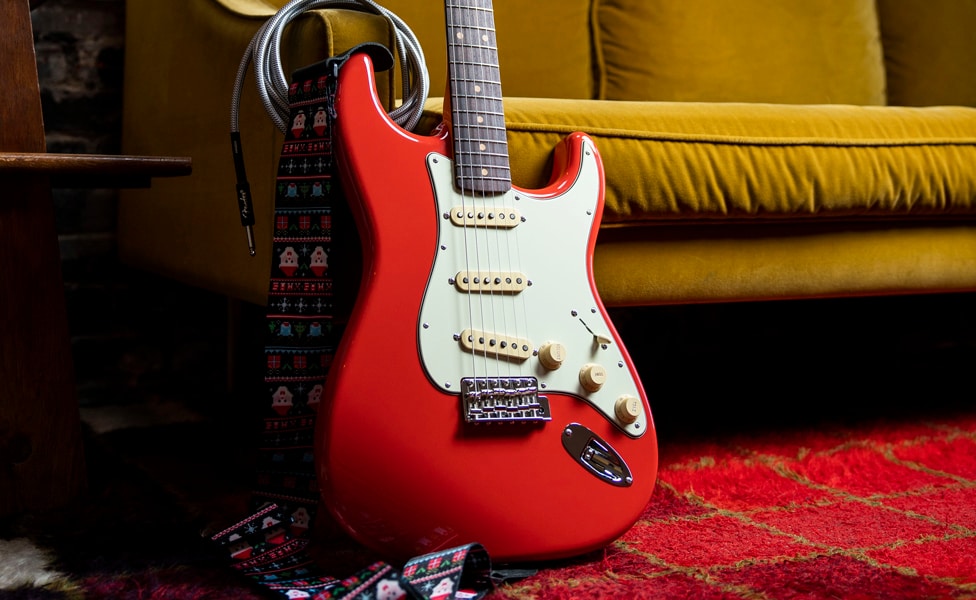
There are a lot of contrasting claims about what the exact line between so-called pre-CBS and CBS-era Strat models should be. For some, it's the January 5 date, as if the universe suddenly reeled and changed on that day. For others—and this is the view we lean toward—the change was a gradual process. For example, if you buy a vintage Strat with a neck and body date stamped in early 1965, while technically a CBS-era instrument, it was almost certainly built with pre-CBS parts by employees who had been working at the factory well before the company changed hands.
As a kind of arbitrary call, we'd say the real symbols of the end of pre-CBS construction was the switch from "L-series" neck plates to ones stamped with a reversed "F", and the new, larger Stratocaster headstock design late in the year.
As a note, this larger headstock was based on an existing design already in use on Fender's offset-body guitars. It might very well have made the transition to the Strat even without CBS' ownership, as Don Randall was always looking for a bigger canvas to showcase the brand.
Changes to the Stratocaster in the CBS Era
CBS ownership was hallmarked by the emphasis on production numbers, controlling costs and maximizing shareholder return. Here is a list of a few of those feature changes that are seen by some Strat aficionados as detrimental.
- Micro-Tilt Neck. Devised by Fender and Tavares while they were consultants to the CBS/Fender company, the tiltable guitar neck allowed adjustment of the angle of the neck in relation to the body to achieve optimal playing action. Initially viewed negatively, the Micro-Tilt concept apparently got a bad rap. It’s still used today on some models, such as the Albert Hammond Jr. Signature Stratocaster.
- Poylurethane Finishes. CBS moved from nitrocellulose lacquer to less-toxic and easier-to-manage polyurethane finishes. However, Polyurethane was most notoriously labeled as a "Thick-Skin" finish. While certainly durable, polyurethane had a plastic-like appearance, and could lead to a sticky neck feel in humid conditions.
- 3-bolt Neck Plate. In 1971, the Stratocaster’s 4-bolt neck was replaced by a 3-bolt design. This was not necessarily a bad change—if the neck pocket has the correct tolerances, 3-bolt necks should not present any problems—but it was reportedly initiated by CBS purely to reduce production costs. And, as quality control wanted during the CBS years, those neck pockets were not always cut to spec.
- Vinyl Pickguards. In 1965, the pickguard was changed from three layers of celluloid to ABS or vinyl. Originally—we’re talking 1954 to 1959—many Fender instruments had pickguards made from a single sheet of celluloid. The vinyl varieties still protected the top of the guitar from pick scratches, but apparently, they’re not as prized by collectors.
- One-Piece Die-Cast Bridge. Originally, the Strat’s tremolo bridge had a base plate and an inertia bar made from two separate pieces. The die-cast version—which appeared in 1971—was cheaper, less robust and purportedly robbed the guitar of sustain and tone.
- Inconsistent Body Contours. The shapely curves that were considered revolutionary when the Stratocaster debuted in the early 1950s seemed to become less distinct during the later CBS years. Tight production deadlines are sometimes blamed, and the problem became one of inconsistency, rather than a corporate decree. Some CBS Strats do possess those lovely deep contours, but a worker in a bad mood fashioning a body without a template could produce something far less curvaceous.
- Microphonic Pickups. Given the CBS concerns about production costs, it’s not a surprise that hand-guided pickup winding was replaced with auto-winding machines. But, allegedly, the corporation had the factory stop dipping the pickups in wax to prevent vibration and feedback. As a result, some Stratocasters from this era can squeal, wail and amplify handling noises on the guitar body. Be mindful of this, if you’re shopping our extensive collection of vintage Stratocasters.
- 5-Way Pickup Selector. On the bright side, CBS management was the one to finally change to a 5-way pickup selector switch in 1977. At long last, players had “official” access to the balancing act of the in-between switch positions that produced those classic Stratocaster funky and snarling nasal-like tones.
Beyond all of the design transformations, Fender appeared to be a “cash cow” for CBS, and the profits from the Fender operation were not always rolled back into the production facilities. This led to the factory falling behind the technological advances of the time, despite attempts to react to a growing market for highly customized and custom-built Strat-style instruments springing out of some small, Los Angeles-based guitar shops.
If you want to dive deeper into the evolution of the Strat during the CBS era, check out 1965-1985 | The Fender Stratocaster During the CBS Era.
The Beginning of the Superstrat
Luthiers Grover Jackson, Wayne Charvel, Dave Schecter and Tom Anderson—along with Valley Arts Guitars—made their first big splash in the world of guitar geekery producing custom, Strat-style guitars in the Los Angeles area starting in the mid-to-late 1970s. With feedback from their customers—many of whom were L.A. studio musicians and rock stars—these guitars offered flashy new looks, different pickup and switching configurations aimed at maximizing the guitar's tonal versatility, and hardware advances like double-locking tremolo systems.
In contrast to the CBS-owned Fender's mass production techniques, these guitars harkened back to Fender's early years. They were rife with experimentation and a sense of doing something new, rather than sticking with the tried and true. Jackson's and Charvel's companies would both end up being purchased by Fender, and their designs are still in production today at Fender's Corona, California, and Ensenada, Mexico factories.
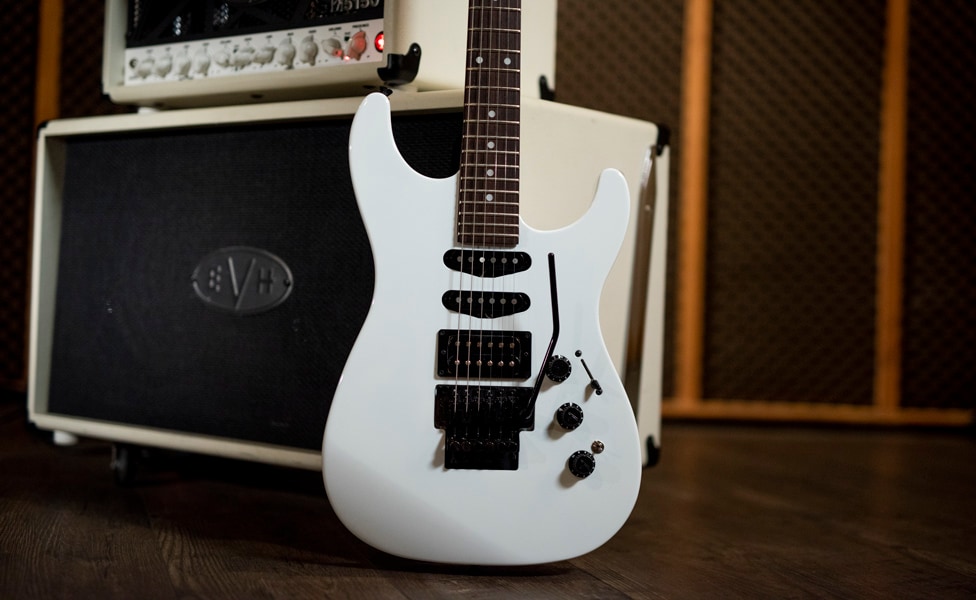
A wild-card factor was also popping up, thanks to the world of companies producing replacement parts for Stratocaster and other Fender guitars. This was, in fact, how both Schecter and Anderson got started (Anderson was, in the early days, the man who wound pickups for Schecter's company). It was easy for a reasonably handy and motivated guitarist to build their own guitar to their exact specifications.
A case in point was a young guitar player from Altadena, California, named Edward Van Halen. Using parts from a variety of suppliers, Van Halen created a striking, fast-playing, stripped-down guitar that would reflect his unique playing style and become a shining beacon of individuality. (Of course, it would end up being widely copied by other DIY guitarists). As Van Halen's ideas about his ideal guitar evolved, the late guitarist partnered with several companies over the years to build and market his concepts, eventually ending up with the EVH brand under the care of Fender.
The Stratocaster in the '80s and Beyond
As styles and fashions in music changed, guitars would wax and wane in popularity. The late 1970s and early 1980s were a slow period for guitar sales, and, combined with CBS' tendency to not reinvest in the Fender factory or research and development for new instruments, sales were not returning the previous level of profit. This was not helped along by the increasing belief among players that commitment to quality control was not a big part of CBS' plan.
In 1981, CBS brought in John McLaren and Bill Schultz from Yamaha to take over their musical instrument division and see if they could turn it around. They brought along Dan Smith, also from Yamaha, to head up marketing. As the new team began the process of renewing players' faith in Fender, CBS committed to invest $2 million for renovation and improvements at Fender's Fullerton factory.
The next four years saw an expansion of new concepts—a number in response to the new world of Superstrats—and a return to proven designs. The latter was showcased with the Standard Stratocaster, which returned to the four-bolt neck, smaller headstock and more deeply contoured body of pre-CBS instruments. New guitars that were tributes to the 1957 and 1962 Strat designs—high watermarks in the model’s history—were also made.
New concepts, such as the Stratocaster Elite, which was created by a team including Tavares, who remained with Fender through the CBS years and until his retirement in 1986 appeared, as well. The Elite included active electronics, a new bi-flex truss rod, a redesigned "Freeflyte" vibrato bridge with a snap-in arm, drop-in string loading and top tension adjustment, a flatter (12") fingerboard radius and other refinements in tuning machines and switching. Some of these “modern” refinements, like the MDX and TBX tone controls, are still around today, while others did not gain player acceptance.
In 1982, Fender Japan was formed, manufacturing their own unique takes on iconic Fender instruments, as well as producing futuristic, strange and whimsical Fender-esque designs. For guitar enthusiasts in-the-know, the Japanese company also popularized the acronyms MIJ (Made in Japan) and CIJ (Crafted in Japan). Following suit, other points of Fender guitar manufacturing established their own acronyms, such as MIM (Made in Mexico), MIK (Made in Korea) and so on.
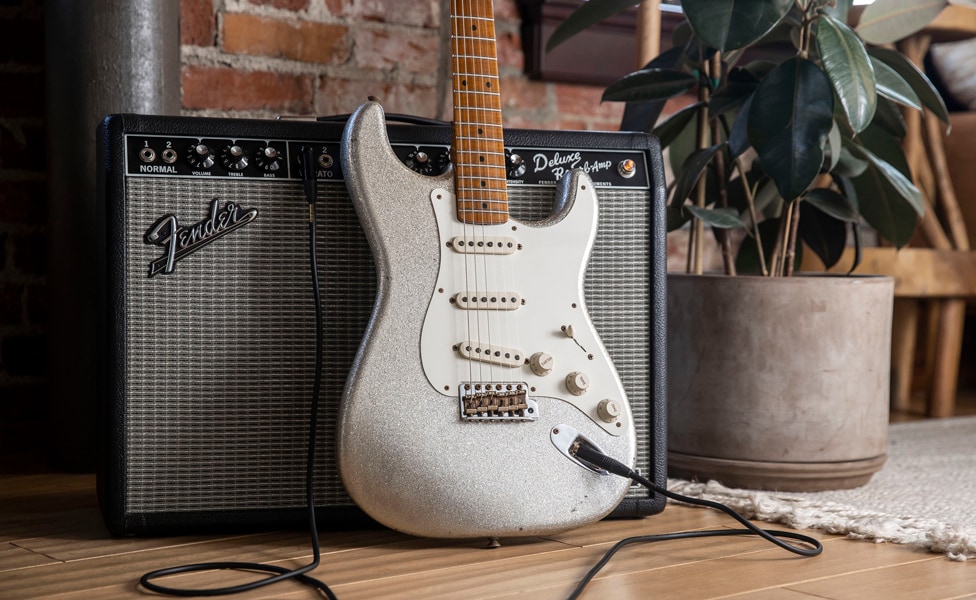
That same year, Fender revived the Squier brand to produce affordable Stratocasters, Telecasters, and other guitars. Fender had actually bought the V.C. Squier Company in 1965, a few years after it had supplied Fender with strings starting in the 1950s. The Squier brand had been retired in the 1970s, when Fender began marketing strings under its own name.
Despite the best efforts and first successes of the new management group, CBS felt a need to retreat to what was still their core business—records and broadcasting—and by 1984, they were beginning to look for a buyer for Fender Musical Instruments. The offer they received, and ended up accepting, was from a group of investors who were, in essence, the entire management team at Fender Musical Instruments, headed by Schultz.
On March 12, 1985, the post-CBS era at Fender was to begin.
The Stratocaster After CBS
The first challenge for the new owners was that, due to funding restraints, the purchase did not include the Fullerton production facilities (which would have, in any case, been far larger than their initial business plans needed). Fender Japan would have to fill the 10-month gap in U.S. manufacturing capacity until the new Fender factory in Corona, California opened in October 1985.
One of the guitars to emerge from that brief period was the Contemporary Stratocaster, which applied many of the features from Superstrat guitars, including a much flatter fingerboard radius and locking vibrato bridges—usually Schaller models.
The first Strat guitars to emerge from the new Corona factory were the ’57 and ’62 vintage models, which had been the most popular of the guitars produced toward the end of the CBS ownership. But after a short-lived attempt to add some of the Stratocaster Elite features to the reissues with the Vintage Plus guitar (one of those features, the 12dB boost, would become a critical part of the Eric Clapton Signature model), they began work on what would be the mainstay Strat for some years to come—the Fender American Standard Stratocaster.
Released at the end of 1986, with Eric Johnson as a principal endorser, the American Standard was a more integrated pass at merging the best features of the vintage models with new features. Notable changes included a redesigned 2-point pivot vibrato bridge with an angled inertia block and stainless-steel saddles, freshly redesigned, flat-pole piece pickups and a 22-fret neck with a flatter-radius fingerboard. It also featured the MDX and TBX tone controls, and the newer, Ezy-Glider string retainers.
In 1988, Fender Japan released the Strat HM, which was a direct shot at the Superstrat category. At first only available in the Fuji-gen built version, U.S. manufacture of the model began in 1990. This guitar was also available as a limited-edition release in 2020.
Other early innovations from the new company would be their deal with Don Lace to create a full line of Lace Sensor pickups tailored for vintage and modern Stratocaster tones. These pickups were a huge part of Eric Clapton’s late ’80 and ’90s sound (especially 1989’s Journeyman album) until they were replaced by Fender’s Vintage Noiseless pickups on his 2001 signature “Blackie” Stratocaster.
The Fender Custom Shop
The Custom Shop began in 1986 under the leadership of Master Builders John Page and Michael Stevens. It was born both as a source for superlative hand-built one-off instruments for artists and trade shows, as well as a manufacturer of custom parts for standard models.
Fender Custom Shop serial number 0001 was a bit of a strange one. Made at Stevens’ Texas shop in 1986, before the Corona facility was ready, it’s a mash up of a Stratocaster and an Esquire, and it’s also notable for being Fender’s first doubleneck guitar. The Custom Shop’s first signature artist model was a recreation of Eric Clapton’s famed “Blackie” Stratocaster.
Since then, the Custom Shop has continued making fabulous signature Stratocasters honoring Dick Dale, Jeff Beck, Rory Gallagher, Robin Trower, Stevie Ray and Jimmie Vaughan, Jimi Hendrix and others—including a replica of a 1962 blonde-finish Mary Kaye Strat, celebrating the guitar and guitarist featured in a 1956 Fender promo photo. (Kaye, a well-known guitarist in her own right, didn't actually own her eponymous Stratocaster until Fender gifted her one in 2002.)
After the birth of the Custom Shop, it becomes much more difficult to track the expanding range of Stratocaster guitars, with a plethora of artist signature models, limited-edition builds, and the branching out of Fender factories and product lines to Mexico, Japan, China, India, Indonesia and many other spots around the globe. Rather than try and make sense of all of that, let us turn to how specific features in the Strat evolved over the decades.
Evolution of the Stratocaster
As with the Telecaster, once the Stratocaster got into the hands of more and more players, it didn't take long for the Strat to begin a sometimes subtle, sometimes less so, evolution. Sometimes it was a change in material, as when the original Bakelite pickguards and pickup covers, which had a tendency to crack, were replaced with a more durable white material late in 1954, then again, with yet longer-lasting ABS plastic, in 1956. Other times, it was an addition, like officially adding custom color choices in 1957, or adding the snap-on chromed bridge cover in 1955, probably to offer a smaller ashtray for players who smoked, as that was the most common use for the Telecaster's bridge cover. With that, we dive into some of the most interesting changes over the Strat's first decade of existence. On a side note, if you want to get a quick look at some of these evolutionary changes, a great place to check them out is scoping out the wide range of Strat models in our vintage collection.
How the Neck Changed
The Stratocaster neck has gone through a number of profile changes over the years—some of which are less simple to track, due to the nature of the early hand-shaping of necks. The original 1954 release had a profile similar to early Telecaster necks, which were referred to by some as "club-like" (but not, we hope, in a bad way).
By early 1955, the Stratocaster neck was beginning to show a hint of a V, and the more-pronounced, classic "boat-neck" V-profile held from 1955 to 1957. From '57 to '59, the profile began to round and flatten, until the C-profile neck—which some feel is the definitive Stratocaster neck profile—was firmly established in 1960.
By the mid-'60s, it had become more of a U profile. Through the '70s, neck profiles could vary quite a bit, as they would depend on who had shaped the neck and how quickly the production schedule forced them to work. Generally, these necks will be somewhere between a C and a U profile—the biggest variation in playing feel for 1970s CBS-era Strat electric guitars.
Fender invested in an automated neck-carving system in the early 1980s, which enabled more consistent production, as well as the ability to have multiple standardized neck profiles that could be selected on a per model or per build basis.
How the Fingerboard Changed
Up until 1959, the Strat fingerboard—also called “fretboard”—was maple, and was part of a one-piece neck, with the truss rod inserted from the back of the neck, resulting in the classic "skunk stripe." Some of those early necks were done with a maple stripe, rather than the more common and contrasting dark wood.
With the introduction of the rosewood fingerboard in 1959, neck construction became two-piece. The rosewood fingerboard evolved from the early "slab" fingerboard, which was a thicker piece of rosewood where both the neck and the fingerboard were milled flat and glued together, to the radius milled "round-lam" fingerboards, where a much thinner piece of rosewood was glued to a pre-radiused neck. The change was made, in part, to more closely match the original Strat tones, as the thicker rosewood slab had reduced the treble and clarity of the guitar.
When maple fingerboard options were reintroduced later in the 1960s, the two-piece construction was continued with the use of a maple cap fingerboard, rather than the single-piece construction of the original necks. The classic one-piece maple neck with skunk stripe has reemerged on the occasional model since then, mostly on vintage reissues. Due to increased restrictions on, and availability of, tropical hardwoods, the use of alternative fingerboard woods like Indian laurel and non-Central/South American rosewood relatives has become more prevalent in recent years. Today, the four most common woods used to construct Stratocaster fingerboards are Maple, Rosewood, Pau Ferro and Ebony.
How the Fingerboard Radius Changed
The other changes in the fingerboard that were important to the evolution of the Strat were multiple adjustments in the fingerboard radius. Like all other early Fender electrics, the Stratocaster started with a 7.25" radius (although, since the fingerboards were radiused by hand, this is approximate. Some early examples have had a fingerboard radius measure as low as 6"—a pretty radical radius). While 7.25" is great for "cowboy chords" and general rhythm playing, as players began to venture further up the neck and bend strings more, while simultaneously wanting lower action and lighter strings, the need for a flatter radius became a priority.
In 1983, Fender changed to a much flatter 12" radius to compete with the Superstrat-style guitars, then standardized on a compromise 9.5" radius that provided a great blend of comfort for chording and shred-ability starting in 1986 with the Standard Stratocaster. In recent years, and most notably with the current Strat Ultra, Fender has begun to build compound-radius necks—frequently 10–14"—which provide the best of both approaches with fewer compromises.
How the Frets Changed
Clinton F. Smith patented the T (or “tang”) fret in 1929, giving guitar manufacturers a secure way to seat the fret into the fret slots of the fingerboard. From there, different fret-wire sizes emerged to accommodate various player preferences. When the Stratocaster debuted in the 1950s, Fender used tiny frets that were often slathered in lacquer. A player’s fingertips would barely feel them as they worked up and down the neck. Fender used these “Vintage” frets until offering other sizes on some models in the 1960s and ’70s. In the CBS era, jumbo-sized frets appeared—again, on some models—but, excepting its Vintage Reissue guitars, medium jumbo frets were not adopted as a standard Fender offering until 1983.
Here are the current fret sizes used by Fender today. The fret material is brass and nickel. Fender doesn’t use stainless-steel frets on any of its guitars.
- Vintage. This is the smallest size (.078" x .043") found on older Fender necks. At present, Fender’s Vintage Size frets are .084" x .039", and it is the size Eric Clapton prefers for his own Stratocasters and his signature models, such as the Fender Artist Series Eric Clapton Stratocaster.
- Medium Jumbo. Sized at .103" x .046", this is the most commonly used fret wire for many Fender models. This fretwire appears on the new Fender 70th Anniversary Player Stratocaster in that gorgeous Nebula Noir finish.
- Narrow/Vintage Tall. Still providing a vintage-esque feel, these frets (.094" x .054") are used when a Vintage fret might be considered too small. This size is currently offered on the Vintera II ’50s Stratocaster, the Vintera II ’60s Stratocaster, and other models.
- Super Jumbo. Big. Big. Big. At .110" x .055", this size is used on the Fender Artist Series Yngwie Malmsteen Stratocaster, and offered by special order in the Fender Custom Shop.
How the Truss Rod Design Changed
The original Fender truss rod, inserted from the back of the neck and with the adjustment at the body end, was the standard from 1954 to 1959. With the change to rosewood fingerboards, the truss rod was inserted from the top of the neck and covered by the fingerboard, with the adjustment remaining at the body end.
With the advent of the three-bolt Micro-Tilt neck in 1971, the truss rod adjustment was moved to a "bullet" truss rod adjustment at the headstock to enable the neck tilt adjustment at the neck plate. Shortly after Fender returned to the four-bolt neck with the Silver Anniversary Strat in 1979, the bi-flex truss rod, able to correct for both positive and negative relief, was developed and the truss rod adjustment, in most cases, went back to the body end of the neck, though many of the overseas manufactured Squier guitars retain the "bullet" adjustment.
How Body Wood and Contouring Changed
Like the Telecaster before it, the Strat began with a swamp ash body. As lightweight ash became harder to get, Fender switched to alder as the principal body wood in 1956, reserving ash, with its more attractive grain pattern, for the transparent blonde finishes, like on the "Mary Kaye" model mentioned above, and some custom colors. Alder remained the default wood for American-built Strat models, aside from the 1970s natural finish guitars which went back to ash for the attractive grain, and for a while, ash made a comeback across all Strat designs, until customer complaints about the weight made for a return to alder in the 1980s. There were also occasional experiments, like the beautiful, but incredibly heavy, Walnut Strat of the early '80s, or the extremely rare handful of mahogany-body Stratocaster builds from the mid-1960s. As quality, lightweight alder has become harder to source, alternatives like basswood and poplar are occasionally used for some Squier models and, of course, the Fender Custom Shop has access to a wide variety of rare woods for one-of-a-kind builds.
The original Strat body had fairly deep and wide back contours, and a more rounded contour under the player's forearm. Over the course of the 1950s, there was a great deal of variation, though they tended to get smaller and shallower, probably because the contours were still being hand-sanded in, and as production numbers went up, the amount of time for sanding went down. Throughout the CBS years, the contours remained fairly shallow, returning to something more resembling their original state post-CBS, especially after the advent of CNC milling of the bodies.
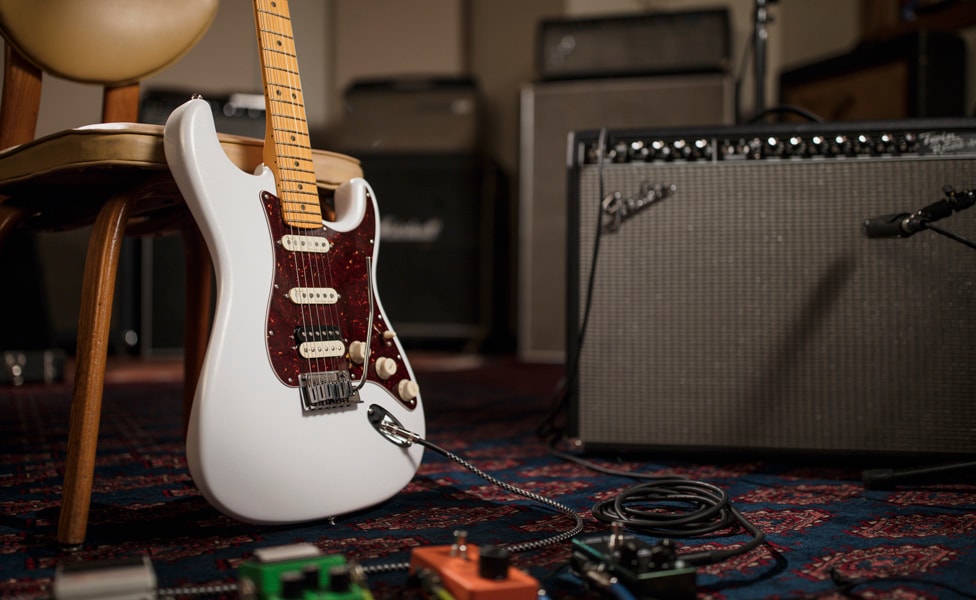
The Top 10 Strat Players By Decade
Putting this section together was a challenge, simply because there have been so many iconic Stratocaster players across so many different genres since 1954. From country to blues to rock to pop, and even the Lawrence Welk band (for those of you too young to remember The Lawrence Welk Show, count your blessings), the Strat has probably been seen on more stages, in more venues, than any other electric guitar. So, here's a collection of Stratocaster artists well worth checking out. If we miss your favorite Strat player, we apologize in advance.
Stratocaster Pioneers of the 1950s
We've already mentioned a few of the Fender Stratocaster players who were there from the beginning, from Rex Galleon and Bill Carson, who were actively involved in the development of the Strat, to Eldon Shamblin and Pee Wee Crayton, who played some of the very first guitars to come out of the Fullerton factory. Buddy Merrill was there from the very beginning, as well, and his tenure with the Lawrence Welk Orchestra spanned from 1954 to 1974. He and his Strat were often given a featured spot on the show.
On the blues and R&B side, the Stratocaster's ascendence was initiated by Ike Turner (check "A Fool in Love" from 1960's The Soul of Ike and Tina Turner for a sample of Ike's solid comping) and Buddy Guy (who started playing a Stratocaster after his Les Paul goldtop was stolen in 1957, and loved the guitar so much, he vowed to be a Strat player for life). If you've never heard them, it's worth checking out Guy’s early recordings for the Chess label, including his classic, "The First Time I Met the Blues," to note how well the Strat tone meshes with his aggressive playing style.
Meanwhile, across the Atlantic in 1959, a young guitar player named Hank Marvin was hired to play in pop sensation Cliff Richard's band armed with what was, legendarily, the first Stratocaster ever to arrive in the U.K.—a custom color Fiesta Red model. Marvin, with Richard's backing band, The Shadows, became Britain's first guitar hero with the instrumental "Apache," and a star in his own right. It's said it was almost impossible to sell any Strat other than a Fiesta Red model in Britain for the next several years.
- Pee Wee Crayton
- Buddy Guy
- Buddy Holly
- Mary Kaye
- Hank Marvin
- Johnny Meeks
- Buddy Merrill
- Carl Perkins
- Ike Turner
- Ritchie Valens
Top Stratocaster Players of the 1960s
As rock ’n’ roll was undergoing changes in the early '60s, the advent of surf music kept the Stratocaster in the spotlight with players like Dick Dale ("Miserlou") and The Beach Boys' Al Jardine sporting Strats. But the ’60s Strat eruption really began in 1967, when Jimi Hendrix released his first album and changed the face of rock forever. Hendrix's performances at the Monterey Pop and Woodstock music festivals and on the live Band of Gypsys album solidified both the image and sound many players would chase for years thereafter.
Many other influential guitarists picked up their own Stratocasters and made an impact. For example, George Harrison and his painted “Rocky” Strat, Ritchie Blackmore's bombast with Deep Purple (deep cut recommendation—the cover of Neil Diamond's "Kentucky Woman" from The Book of Taliesyn), Irish blues/rock guitarist Rory Gallagher and his amazingly beat-up 1961 Strat ("Bullfrog Blues" from his 1972 Live In Europe) and Richard Thompson's electro-folk explorations with Fairport Convention ("Time Will Show the Wiser").
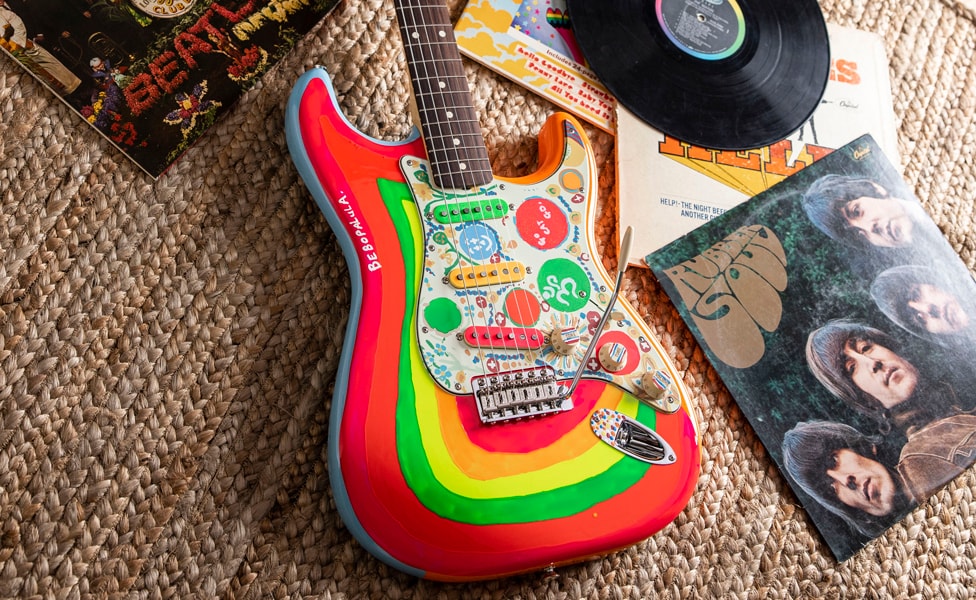
Meanwhile, back here in the colonies, Strat models were back in the spotlight as well, with players like the late Terry Kath of Chicago, whose burning playing was said to have inspired Hendrix after having seen the band at the Whisky a Go Go in L.A. (check all the live versions of "25 or 6 to 4" on the At Carnegie Hall album) and soul singer/songwriter/guitarist Curtis Mayfield whose singular rhythm style with The Impressions on songs like the original version of "People Get Ready" was highly influential for players like Jimi Hendrix and Jeff Beck (Mayfield's stripped-down recording of this on his 1973 Curtis Live album is a great showcase for his distinctive rhythm style).
- Ritchie Blackmore
- Dick Dale
- Bob Dylan and Robbie Robertson
- Rory Gallagher
- George Harrison
- Jimi Hendrix
- Al Jardine
- Curtis Mayfield
- Richard Thompson
- Pete Townshend
Stunning Strat Players of the '70s
If the 1960s were a Stratocaster resurgence, the 1970s were a positive explosion. From David Gilmour's distinctive Strat work with Pink Floyd and Eric Clapton breaking out "Brownie" and "Blackie" (on display at Guitar Center's Hollywood store, along with his Cream-era Gibson ES-335) for Delaney & Bonnie and Layla and Other Assorted Love Songs ("Bell Bottom Blues" is a great cut to check out there), the Strat was increasingly the go-to guitar. This status was reinforced after Jeff Beck put down his Les Paul and picked up a Strat for his seminal Blow by Blow album ("'Cause We've Ended Now as Lovers," an instrumental reworking of a Stevie Wonder/Syreeta Wright song, may be the most influential track from that record). Also check out Terry Kath of Chicago on the live version of "25 or 6 to 4" on the At Carnegie Hall album. Kath’s burning playing was said to have inspired Hendrix after seeing Chicago at the Whisky a Go Go in L.A.
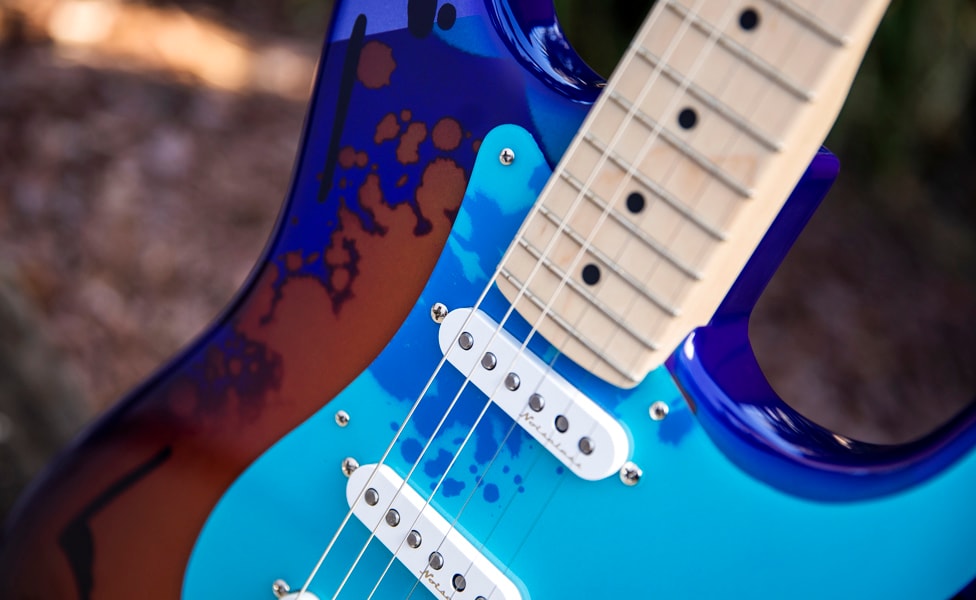
The Stratocaster was also favored by many slide players, notably Bonnie Raitt, Lowell George of Little Feat and Ry Cooder (check out Cooder's work on The Rolling Stones' Jamming With Edward, especially on their version of Tampa Red's "It Hurts Me Too," and George's playing on Little Feat's "Skin It Back"). Nile Rodgers' work as a producer and session player helped establish Stratocaster tone as a funk essential, most notably on Chic's hit dance-driven song, "Le Freak."
Finally, we can't leave this decade without mentioning Funkadelic guitarist Eddie Hazel's 10-minute solo on "Maggot Brain," which has been hailed as one of the greatest guitar solos ever recorded.
- Jeff Beck
- Eric Clapton
- Ry Cooder
- Jerry Garcia
- David Gilmour
- Eddie Hazel
- Terry Kath
- Mark Knopfler
- Bonnie Raitt
- Nile Rodgers
Great Strat Players of the 1980s and '90s
The plethora of Stratocaster players from the '80s onward makes selecting just a few a challenging task, so we're touching on some of the more resonant players and moments here. Jeff Beck continued to innovate, with further explorations into jazz fusion and electronica (the whole of his Guitar Shop album is a study in Strat). Texas Stratocaster players were definitely in the mix, with Stevie Ray Vaughan (the sessions he recorded with blues legend Albert King, are a must-listen) foremost among them.
Incidentally, if you're ever in the Guitar Center store in Austin, Texas, you can see, proudly displayed, SRV's "Lenny" Strat along with his pedalboard setup.
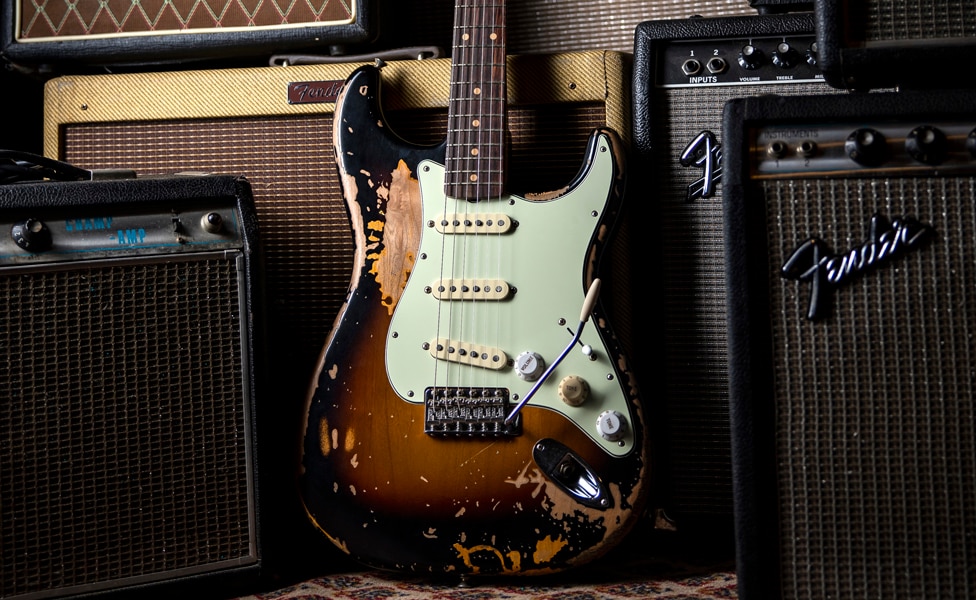
A soft-spoken, dazzling player named Eric Johnson (give a listen to Ah Via Musicom, which includes his signature piece, "Cliffs of Dover") also brought Texas Strat-packing pickers into the public eye. (We also recommend checking out Chris Duarte's Texas Sugar Strat Magic album for a different take on Texas blues.) Pearl Jam's Mike McCready brought Strat vibe and tone to the burgeoning grunge scene in the '90s. L.A. studio musician Michael Landau's work with a Stratocaster on many recording sessions put the classic Strat signature tones at the forefront of many hits (check Landau's work with drummer Steve Gadd on several of the Steve Gadd Band albums), and jazz fusion/blues artist Scott Henderson amazed many with his work with Chick Corea's Elektric Band, the Zawinul Syndicate and fusion sensations Tribal Tech, as well as his unique take on the blues in his solo recordings.
- Robert Cray
- John Frusciante
- Scott Henderson
- Eric Johnson
- Michael Landau
- Yngwie Malmsteen
- Mike McCready
- Dave Murray
- The Edge
- Stevie Ray Vaughan
Contemporary Strat Artists
A sign of the ongoing popularity and tremendous versatility of the Fender Stratocaster can be seen from the range of already established and fresher contemporary artists who are seen on stage proudly playing one. From country newcomers like Jason Isbell, funk players like Cory Wong (Vulfpeck), blues-based artists like Ana Popovic adventurous rockers like Radiohead's Ed O'Brien and Weezer's Rivers Cuomo, jazz players like Mark Lettieri and Bob Manzetti (who provide a two-pronged Strat attack for Snarky Puppy) and platinum pop artists such as Bruno Mars and H.E.R., the Strat continues to shine as the versatile, expressive and evocative voice for millions of players worldwide.
We're particularly impressed with Australian multi-instrumentalist Tash Sultana, whose playing with her signature Stratocaster on "Big Smoke" from her Flow State album is a beautiful example of what great clean Strat tone can be. In the tradition of singer/songwriters picking up a Stratocaster—dating back to Bob Dylan's Newport Festival appearance in 1965—many current performers have a Strat as their go-to, such as YouTube phenom Beabadoobee.
- Beabadoobee
- Rivers Cuomo
- H.E.R.
- Jason Isbell
- Mark Lettieri and Bob Manzetti
- Bruno Mars
- Ed O'Brien
- Ana Popovic
- Tash Sultana
- Cory Wong
The Fender Stratocaster at 70
At 70, most people are retired and taking it easy. For the Fender Stratocaster, we like to think it's just getting started. The only electric guitar that has been in continuous production for longer than the Strat, is its older sibling, the Telecaster. (Note: Gibson had stopped production of its venerable Les Paul model from 1961-1968—which certainly didn’t hurt the continued ascendence of the Stratocaster.)
The longevity and enduring relevance of the Stratocaster is due to the genius and simplicity of its original design—a platform that exists to reflect the creativity of the individual player. The seemingly never-ending refinements are critical to keeping the Stratocaster innovative and inspiring.
.jpeg)





